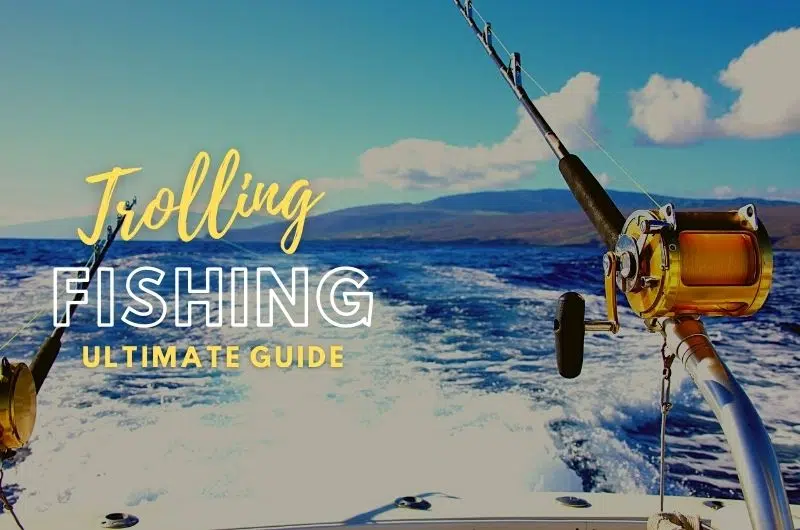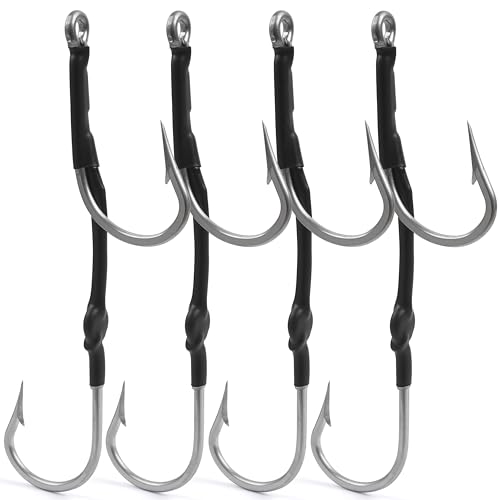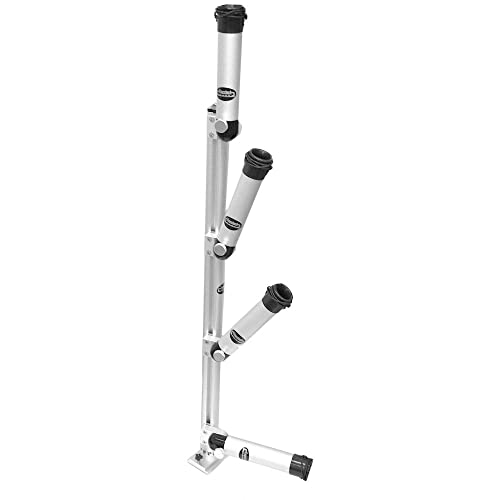Trolling fishing is a great way to catch big fish, but too many people don’t know how it works. If you need to learn more about offshore trolling and how it can help you land the big one, then this article will be the best investment of your time that you’ve ever made.
In fact, with our step-by-step guide, we’ll walk you through everything from what equipment to use and where to go so that before long, you’ll be reeling in those tasty fish!
This fishing trolling guide covers all aspects of trolling, including choosing the right gear and equipment for your needs and selecting the proper braided lines or fishing lines and hook size.
It also explains how different lures work better at specific depths or speeds, ensuring that every trip out on the water results in a successful haul.
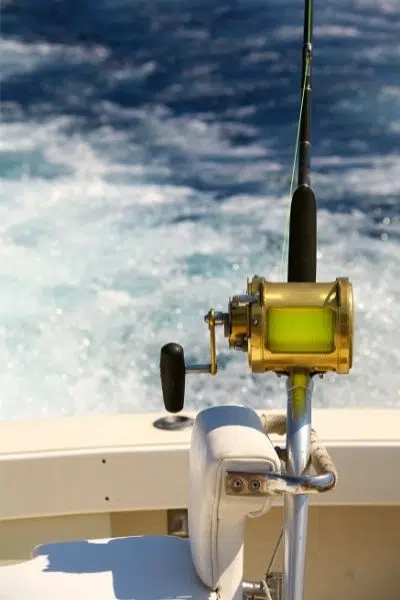
Quick Jump
ToggleWhat does trolling mean in fishing?
Trolling is a way of fishing that involves moving slowly through the water to catch different types of fish. The standard form of trolling can consist of using one or more lures behind a boat or other vessel, but it can also be done by pulling multiple trolling lures on an individual straight line.
Trolling is the preferred method for catching deep-dwelling fish because they are typically found where the lake or river’s depth changes by a significant amount, which results in more area being covered as your boat move through it.
For example, if trolling were used for catching fish at night, you would head to deeper water shortly before sunset and then start the process of letting outline while moving boat slowly forward.
Depending on how fast you go, different species of fish like pelagic fish will be attracted to your bait because they respond better at certain speeds—which is why we’ve included a table for reference. It’s also important to note that trolling works best when fish are active, so you will want to fish during the warmer part of the day.
Is trolling a good way to catch fish?
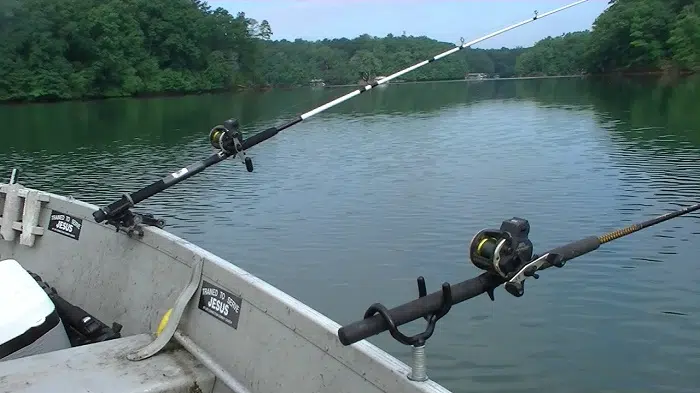
Trolling is probably one of the most popular fishing techniques out there. It’s an effective way for fishing and can be equally exciting for beginners or experts alike, partly due to its unpredictable nature that often leads fishers on a rollercoaster ride where anything could happen next!
But trolling works well because it mimics what naturally happens in the world’s oceans, ponds, and rivers. Fish are always looking for another meal, and realistically what fisherman will spend hours on end standing entirely still when they can enjoy a slow pace while trolling?
When it comes to fishing, trolling is the process of moving a boat with one or more lures behind it to elicit a biting response from predatory fish—in other words, trolling means dragging a line and lure(s) through the water so that you can attract fish who will try to eat your bait. This method differs from still fishing because you’re moving forward instead of standing still.
In addition to the ability to cover more water, trolling also makes it easier for anglers to target specific species of fish—which is excellent news if you’re looking to catch a particular type of fish.
When you troll, you can choose the proper lure and speed so that it’s more likely to attract the species of fish that you want to eat.
Where is trolling fishing used?
Trolling can be used in any body of water with fish in it, but trolling is most commonly found on open water, such as in a lake or the ocean. In addition, trolling can be done from boats and ships and along shallow reefs, shorelines, and even rivers.
Since trolling works best in deeper water, anglers typically troll the shorelines looking for prey along with the deepest possible points that they can find. For example, this is why trolling is very common in large bodies of water like the Great Lakes, where there are many different types of fish trying to feed in a limited amount of space.
How do you troll fishing? (Catching fish trolling techniques)
As stated above, trolling is the process of dragging lures behind a moving boat or other vessel either by pulling it on an individual line or trolled behind the boat with one or more fishing lines.
There are different ways to troll, but most troll with multiple fishing rods attached to one or more reels. This way, you can take advantage of different types of trolling lures instead of just one type.
Some fishermen troll with a single line that has multiple lures attached to it in a way that makes a long V-shaped trail behind their boat.
Trolling with multiple lures looks more like a circle of lures around the boat than just one V-shaped trail—which allows the boat to cover more water.
Fishing trolling techniques and fish species
Fishing trolling techniques should be developed based on the type of fish you’re trying to catch and where they are located. For example, a technique that works well for catching fish in a shallow pond will not be as effective if you’re fishing in the open ocean.
As we mentioned in the introduction, trolling works best when fish are hungry and actively feeding. This is why you should troll when you see fish jumping out of the water, fish busting bait on the surface, or fish feeding near the structure.
Trolling is effective for both freshwater and saltwater fish, but trolling is especially effective in saltwater because it can be used on both calm and rough waters. Again, this is because lures are dragged behind boats instead of a fisherman standing completely still, like when fishing from a bank.
Trolling fishing techniques
Trolling techniques can be broken down into two different categories: vertical and horizontal trolling.
Just like the names state, in a vertical trolling scenario, fisherman drop their trolling baits down towards the bottom of the body of water, while horizontal trolling involves closely towing your lures behind the boat in a horizontal direction.
Vertical trolling works best when trying to fish that are near the bottom of the water body. In addition, vertical trolling is also great for catching species like barracuda and grouper.
Horizontal trolling works best when fishing for species that are located in mid-depth waters. Species like this include:
Trolling is also commonly used to hunt fish during the winter months when the fish are much more sluggish, making it easier to catch them.
Is trolling illegal?
Many states do not have any laws that make trolling fishing illegal. However, there are a few restrictions for where you can troll or what type of lures you can use.
One of the most usual restrictions is that no more than two fishing rods can be used at any given time, so if you’ve got multiple lines and multiple trolling rods attached to one or more conventional reels, make sure they are spaced apart so that you’re not breaking the law.
Another joint restriction is that you cannot drop any fishing gear (including trolling lures) within 100 feet of a public fishing pier. This can be easily avoided by choosing not to troll within 100 feet of the dock.
What are the advantages of trolling fishing?
- Trolling is a highly effective method of fishing. Hobbyists and veteran anglers alike will always choose to troll when they want to catch more fish in less time.
This is because trolling is very versatile and can be used in pretty much any body of water. In addition to this, it can be used to catch a wide variety of species that live in both fresh and saltwater.
- In addition to these advantages, trolling fishing also provides an excellent way for you to cover more area of water. If you’re looking to catch more fish in less time, then trolling is the best way to do so.
Trolling fishing vs. trawling
Trolling and trawling are two very similar fishing techniques. This is because they both involve trailing fishing gear behind a boat in order to catch different species of fish.
In trolling, the fisherman will drop a line from one or more fishing rods while using the boat to maneuver the fishing gear in a vertical manner. On the other hand, trawling involves dragging fishing gear horizontally behind the boat to cover more area of water.
The two most common fishing methods are trawling, which often involves netting and is done for commercial purposes, while trolling uses a trolling rod with most bait or lure to catch fish.
What equipment do you need for trolling? (Trolling fishing gear)
When it comes to equipment, there is some necessary gear and some nice-to-have items that can be used as a replacement or in addition to what’s needed.
Every angler needs to have the three most essential pieces of fishing equipment: a rod, line, and reel. For trolling (or “fishing” as it’s sometimes called), you might also need specific trolling rods with special features for that method; corrosion-resistant trolling lines or hooks are just two examples that come to mind!
What bait do you use for trolling? (Bait for trolling)
Trolling with lures is more effective for chasing bigger fish, while soft plastics are better suited to trolling more miniature games.
Spoons and plugs can be versatile options that fall somewhere in between the two extremes of size-specific tactics; they work well on both saltwater or freshwater rigs (although there’s no one universal rule about which type will attract what kind).
For most anglers’ typical day jaunts out onto open waters, ballyhoo/mullet bait rigs tend towards being faster than heavier weights like plug tales, as you might expect – but this depends mainly upon sea conditions!
Here are the most popular types of bait used when trolling:
– Herring
– Sardines
– Mackerel
– Menhaden
– Anchovy
These are all popular for catching the species that are targeted when trolling. However, other than these, there are many others that can be used as well.
What lures to use for trolling? (Trolling lures)
The best trolling lures (often called “trolling flies” or “jigheads”) are those that have been specifically designed for trolling.
The ones that work best are a little bit of a combination between a jighead and a trolling lure. Trolling flies work so well because they’re designed to attract fish and entice them into consuming the bait. They’re hookless, but the lure’s design allows them to be more aerodynamic and get far more distance.
What species of fish can you catch trolling? (List of fish that can be caught trolling)
There are many species of fish that can be caught by trolling. This is especially true since the fishing technique is so versatile and can be used in both freshwater and saltwater.
In saltwater trolling, most species of yellowfin tuna, wahoo, jacks, Dorado, and pelagic fish/Mahi-mahi, sailfish, and salmon can be targeted with trolling. You can also target many types of cod, halibut, and flounder.
In freshwater, you can catch trout, walleye, bass, or pike. You can also target catfish, carp, sturgeon, and other types of freshwater fish.
What kind of fishing line is best for trolling? (Type of line for trolling)
Fishing line is another crucial thing to pay attention to when you’re out trolling. The line for this type of fishing can vary from nylon monofilament to fluorocarbon.
Depending on the species you’re chasing, there are different line choices that can make a difference in how many fish you catch and what kind. A saltwater trolling line tends to be thicker and more robust than a freshwater trolling line because of the harsh conditions it’s put through.
Monofilament is the easiest to find and cheapest, but it’s also less abrasion-resistant than other line types.
The main benefit of fluorocarbon is its invisibility. It’s more expensive, but it has the best stealth factor out of all trolling line types.
Top 3 Recomended fishing lines for trolling
- Performance Lead Core is designed with a high density lead center...
- 11 Color sequence, 10 Yards per color.
- Performance Lead Core is designed with a high density lead center...
- 13 Color sequence, 10 Yards per color.
- Package Dimension :5.1 cm x 10.4 cm x 10.4 cm
- Package weight : 0.544 kilograms
- Product type :FISHING LINE
- MADE IN China
What is size fishing line best for trolling? (Size of line for trolling)
The choice of what size fishing line you use for trolling is essential. Too thin of line won’t last long, while too thick of line is not good for getting distance when reaching maximum speed.
The fishing line for trolling comes in many different spool sizes. Depending upon what you’re targeting, this can make a big difference in the outcome of your fishing trip.
You can use monofilament with 20-30Lb class gear which will cover most of your needs in this situation and also help you avoid any nasty surprises when it comes down from an unexpected encounter!
What are the best trolling fishing reels? (Picking a trolling reel)
Trolling reels are a type of fishing equipment designed to be used with offshore trolling.
They have greater line capacities and stronger drags than baitcasting ones, allowing them to work better in deeper water where larger fish live near the bottom, also known as “sinking.”
The trolling fishing reel you should use for trolling depends on the other components in your trolling rig. Make sure that the reel you choose fits all of the parts in your rig, which includes the fishing line, trolling rod tip, and lure.
What size hook for salmon trolling? (Hook size for trolling)
The size of the hook you use for trolling depends on which species you are trying to catch. A good piece of advice is to use a hook that’s smaller than the bait you’re using. This should be about 3/0 for lures and flies and 4/0 for live trolling baits.
In general, it’s an excellent idea to use hooks with short shanks and high-carbon steel, so they don’t bend or break easily.
Best trolling fishing hooks (Top picks)
- O'shaughnessy Forged Hooks - It's a time-tested and popular hook...
- Saltwater Fishing Hooks - Ringed eye is perfect for trolling,...
- Durable - Fishing Hooks is made of 420 stainless steel for a...
- Straight Shank - Fishing J hooks is perfect for using long...
- SALTWATER HOOKS: Double Hooks Rig crafted with 420 stainless...
- DURABLE: Double trolling hooks are connected by 7×7(49...
- TROLLING PERFORMANCE: The Saltwater Trolling Hooks is designed to...
- OPTIMAL PRESENTATION: Heavy-duty 180 degree double hook rig can...
- High Strength Construction: These trolling hooks are crafted from...
- Ultra Sharp & Rust Resistant:Precision engineered for ultimate...
- Versatile Trolling Solution:Designed for use with a variety of...
- Easy to Use:Featuring a large eye and a slightly turned in point,...
- STRONG: Saltwater tuna hooks for big game fishing. Made of the...
- SHARP HOOKS: Trolling hooks has conical point that is unequaled...
- ADVANTAGE: Open gape with a bevelled point, forged and ring eye....
- WIDELY APPLICATION: Big game hooks prefect for saltwater fishing....
- DOUBLE FISHING HOOK RIG: Heavy-duty 180 degree double hook rig,...
- SALTWATER HOOKS: Made of 420 stainless steel, forged Shank, high...
- DURABLE: 7x7 (49 strand) stainless steel cables are...
- HIGH PERFORMANCE: The stainless steel double hook rig has the...
Where do you mount a trolling rod holder?
If your trolling motor is just a little off-center, place trolling rod holders on the opposite side to keep them out.
For example if you have mountings that are slightly mounted left from the center (in this case towards the front), use right-side mounts for mounting purposes when at sea and tacking into wind warily so as not to disrupt balance while underway.
- Made by marine grade T6 aluminum with CNC processing
- Heavy duty construction,fo the heavier class trolling Rod holder
- Three rod holders smooth and easy angle adjustment ,Swivels 360...
- Kit also includes track base , stainless steel hardware
- All anodized aluminum construction, low glarefinish
- Great for salt or fresh water
- Smooth and easy pole angle adjustment
- Easy two knob removal
- 【HIGH QUALITY】Made of Stainless Steel, marine grade,...
- 【STRONG CONSTRUCTION】 Vinyl liner has 1-5/8" ID. Great as a...
- 【ADJUSTABLE】Rod holder tube angle from the water can be...
- 【HIGH POLISHED】Mirror polished stainless steel construction....
- VBT-3 stands 29" from Bottom of post to top of post
- Exclusive post design allows independent rod holder...
- Each rod holder has six available positions in a 90-degree area...
- Signature textured finish adds durability to the aluminum...
- 36" tall with 3 45 degree Rodholders, a net/vertical rodholder in...
- Swivels 360 degrees and locks in 4 90 degree positions
- Marine grade powder coat, Stainless Steel and aluminum...
Do you need planer boards to troll?
Planer boards are used in conjunction with downriggers to spread the lures out.
When you set out to start trolling, make sure that your planer boards are on the opposite side of where your downrigger is mounted. Planer board can also be used with a trolling motor to spread lures out across the water.
Planer boards are typically made of plastic, fiberglass, or wood, although metal ones can also be used, depending on what they are made of.
Can you cast with roller guides?
It’s not advisable to use a stiff rod with roller guides when trolling because you’ll end up tangling your line. However, if they are already cast out, try to pull the line off them slowly by flinging it back with your arm. If this still doesn’t work, you can pull the line out of them by attaching a rope.
Roller guides are used for baitcasting reels and rods. When trolling with roller guides, make sure the line is in gear and ready to pull off of them. You can also try using a trolling reel or tension release to get the line out of them.
What is a good trolling speed for fishing?
Boat speed is a big factor in determining whether you’re successful with your fishing trip. Trolling between 1-2 mph as measured by GPS for walleye, trout and salmon are generally effective, while slower speeds may not work the same way because these fish tend to be less spooky than their faster kin.
When trolling, the speed of your boat depends on the type of fishing you’re doing and what type of fish you’re trying to catch.
Higher speeds are usually better when trolling for species that are more sensitive to movement.
Can you fish without a trolling motor?
A trolling motor is a small electric engine that you can use to power your boat. They’re used almost exclusively for angling and are often attached to the back of a boat or kayak to help you move through the water more efficiently.
You don’t need a trolling motor to get the job done, but they can make a massive difference in how well your fishing trip goes. Trolling motors are relatively inexpensive and easy to maintain, so it’s a good idea to have one for your boat.
Does trolling speed affect lure depth?
The trolling speed can make all the difference. We did some testing with real-time depth sensors that indicate how decreasing boat speed will allow the lure to reach deeper water, whether you’re using downriggers or not.
The same can be said for different angles and desired depth lures, as the speed will affect the sound signature of your vessel.
You can troll faster or slower, depending on the fish you’re trying to catch. Make sure that your boat speed is fast enough to keep up with other fishing boats around you, but not too fast.
If you go too fast, the sound of your boat will scare off all of the fish from a wide area around you.
How to determine lure depth while trolling?
There are two ways you can determine the exact depth/lure/speed relationship of a specific rig.
The first is to deploy it and watch as it drags bottom, then slowly start making your way up hills until that sluggish feeling starts happening more often than not; this will tell me how far out into the water I should go before setting off at full power for my lure(s) or anchor system’s weight distribution point where there isn’t too much resistance on one side only (i.e., getting stuck).
The second option would be to take your GPS speed, then calculate either time or distance, whichever you prefer.
I always like distance since that’s what my depth sounder shows anyway. If I calculate time, then if my unit slows down for any reason, I can’t be precisely sure what the speed is since it’s not showing on the unit anymore; whereas if I calculate distance, then all I need to do is note how far out I went and go back that same distance, or pace it off.
It’s relatively simple to figure out how deep your lure is with a bit of math. If you know your boat speed, how far you went, and the time it took to go that distance, then it’s easy to find out just how deep your lure is at that specific speed and time.
How far behind the boat should you troll?
The ideal distance behind a boat varies depending upon what kind of engine it has- from 20 feet all way up into 150+ feet if using gas engines instead of outboard diesel models.
Though these distances may seem like different lengths at first glance – make sure not to hold back too much either time because both approaches have pros & cons, which should influence where/how far away each gets set while being fished from decks within power boats themselves.
How fast should you troll for catfish?
A fisherman’s pace is crucial when it comes to catching a lot of fish. Many anglers trolling conventionally often run from 2-5 mph, while slow trollers rarely go faster than one mph.” You move your catfish bait at precisely the right speed in precise areas; this will help get them biting quicker and more accessible at all times.
What is a good trolling speed for walleye fishing?
When it comes to trolling rigs and their speed, keep them up at 1/3 of the water depth you want. For example, if your water depth is 10 feet, a speed of 3.33 feet per second will keep your rig in the sweet spot in that water column.
Conclusion:
Trolling fishing is a technique that uses an artificial lure to attract fish. There are many different ways to troll, from surface trolling, lures near the water’s surface, and deep-trolling below the ocean floor. In this blog post, we’ve covered all aspects of trolling fishing, as well as some safety tips for beginners who want to try this unique form of fishing.
The best way to learn how to do something new is by going out there and doing it! Is now your time? Let’s catch some fish and get trolling success!
You might also like:

